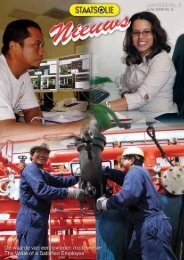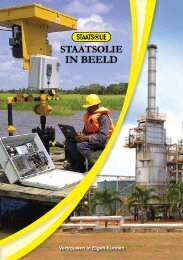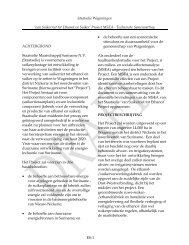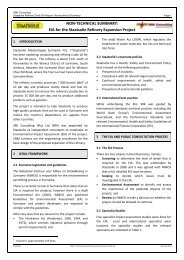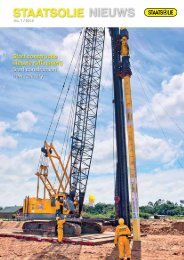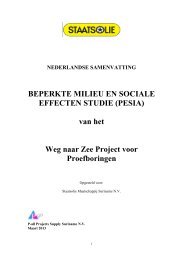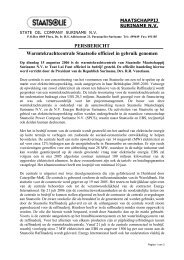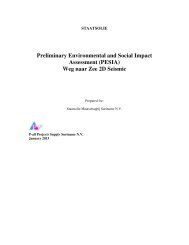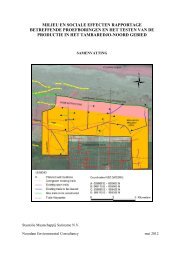(PESIA) Weg naar Zee 2D Seismic - Staatsolie
(PESIA) Weg naar Zee 2D Seismic - Staatsolie
(PESIA) Weg naar Zee 2D Seismic - Staatsolie
Create successful ePaper yourself
Turn your PDF publications into a flip-book with our unique Google optimized e-Paper software.
P-all consultants <strong>Staatsolie</strong> Maatschappij Suriname N.V.<br />
<strong>PESIA</strong> <strong>Weg</strong> <strong>naar</strong> <strong>Zee</strong> <strong>2D</strong> <strong>Seismic</strong> 2012<br />
Table 8: Observed species richness within the Wayambo Swamp Area (E2 Canada & Golder, 2000)<br />
study area<br />
Group of organisms Observed<br />
Vascular plants 161<br />
Mammals 53<br />
Birds 96<br />
Reptiles and Amphibians 13<br />
Fish 28<br />
4.3.3.1 Mammals<br />
In Suriname, the mammalian fauna of the coastal zone has never been systematically<br />
inventoried. Although no mammals have been observed during field trips it is expected that the<br />
53 species mentioned in table 8 can be found in the <strong>Weg</strong> <strong>naar</strong> <strong>Zee</strong> area.<br />
4.3.3.2 Birds<br />
The mudflats and the mangrove zone between the Coppename and the Suriname River<br />
(including the present study area) are important feeding and nesting grounds for residential<br />
coastal birds and the most important feeding grounds for migratory birds from the north<br />
(including from Canada). The inland swamps are also important feeding grounds for rare and<br />
vulnerable resident birds.<br />
The following facts are noteworthy:<br />
• The mangrove zone between the Coppename and the Suriname River is listed on the Ramsar<br />
List (1985) as a "Wetland of International Importance, especially as Waterfowl Habitat"<br />
• According to Scott and Carbonell (1988), the mangrove zone between the Coppename and<br />
the Suriname River is the living area of 12 "Waterfowl species of International Importance"<br />
among which are the scarlet ibis, 3 heron species, 5 species of shore birds, the black skimmer<br />
(Rynchops niger), the common tern (Sterna hirundo), and the rufous crab-eating hawk<br />
(Buteogallus aequinoctialis).<br />
• In the freshwater swamps between the Coppename and Suriname River mouths, the least<br />
bittern (Ixobrychus exilis), a rather rare bittern from freshwater swamps, is very common.<br />
4.3.3.3 Herpetofauna<br />
According to Ouboter, herpetologist and contributor to the Tambaredjo Baseline Study (IBT,<br />
1999), the number of reptiles and amphibians in the Tambaredjo Swamp is limited (n = 13) and<br />
no rare or endangered species are found in that area.<br />
During their nesting season, spectacled caimans (Caiman crocodylus) may become aggressive.<br />
Anacondas (Eunectes murinus) may become very large in the inaccessible parts of the Wayambo<br />
Swamp. It is also noteworthy to mention that on the ridges, especially in the <strong>Weg</strong> <strong>naar</strong> <strong>Zee</strong> area,<br />
51




